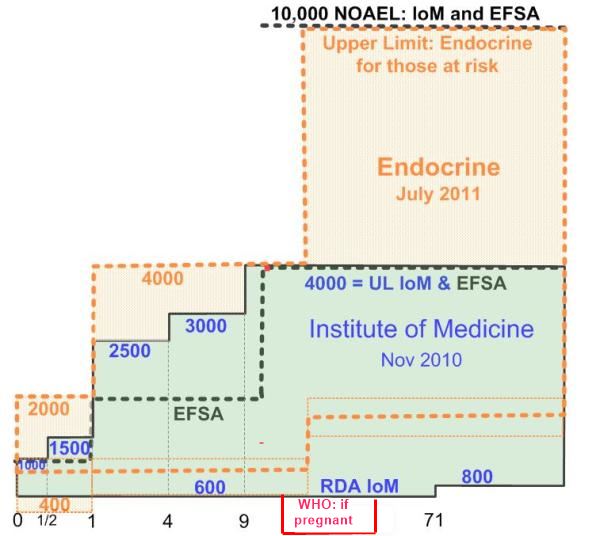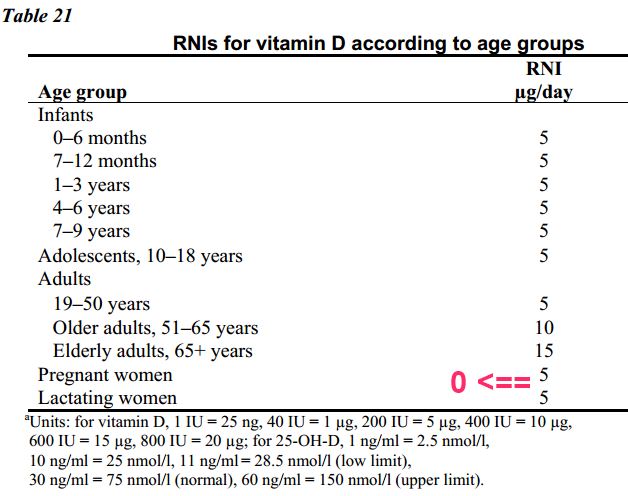WHO recommends zero vitamin D during pregnancy, rest of the world disagrees – 2018, 2020
Compare IOM and WHO
| Organization | most adults | Elderly | Pregnant |
| IOM RDA | 600 IU | 800 IU | 600 IU |
| WHO RNI | 200 IU | 600 IU | 0 IU |
Chart adapted from Vitamin D Recommendations around the world - IU and ng

WHO: Vitamin D supplementation during pregnancy
WHO: Vitamin D supplementation is not recommended for pregnant women to improve maternal and perinatal outcomes
WHO allows 200 IU to be given only if the pregnant women has a proven Vitamin D deifciency
within normal limits | | Randomized Controlled Trial | | 10. Childhood Wheezing | **1.3 times| Randomized Controlled Trial | | 11. Additional child is Autistic | 4 times| Intervention | | 12.Young adult Multiple Sclerosis | 1.9 times| Observe | | 13. Preeclampsia in young adult | 3.5 times| Randomized Controlled Trial | | 14. Good motor skills @ age 3 | 1.4 times| Observe | | 15. Childhood Mite allergy | 5 times| Randomized Controlled Trial | | 16. Childhood Respiratory Tract visits | 2.5 times * | Randomized Controlled Trial | --- The articles in Pregnancy AND Intervention are here: {category} --- The articles in Pregnancy AND Meta-analysis are here: {category} --- 1. WHO recommendation of 200 IU during pregnancy was reduced to 0 IU (by 2018)

📄 Download the PDF from VitaminDWiki
Remarks
This recommendation supersedes the previous WHO recommendation found in the 2012 Guideline: vitamin D supplementation in pregnant women (1).
Pregnant women should be advised that sunlight is the most important source of vitamin D. The amount of time needed in the sun is not known and depends on many variables, such as the amount of skin exposed, the time of day, latitude and season, skin pigmentation (darker skin pigments synthesize less vitamin D than lighter pigments) and sunscreen use (1).
Pregnant women should be encouraged to receive adequate nutrition, which is best achieved through consumption of a healthy, balanced diet, and to refer to WHO guidance on healthy eating (2).
For pregnant women with documented vitamin D deficiency , vitamin D supplements may be given at the current recommended nutrient intake (RNI) of 200 IU (5 µg) per day.
According to the Cochrane review, there are 23 ongoing or unpublished studies on vitamin D supplementation in pregnancy (3). Evidence from these trials should help to clarify the current uncertainties regarding vitamin D effects, particularly the effect on preterm birth, and any other associated benefits or harms of vitamin D when combined with other vitamins and minerals, particularly calcium.
This is an extract from the relevant guideline (4). Additional guidance information can be found in these documents.
References
1. Guideline: Vitamin D supplementation in pregnant women. Geneva: World Health Organization; 2012 [archived]http://www.who.int/nutrition/publications/micronutrients/guidelines/vitdsupppregnantwomen/en/
2. Healthy diet. Fact sheet No. 394. Geneva: World Health Organization; 2015 [http://www.who.int/ mediacentre/factsheets/fs394/en/]
3. WDe-Regil LM, Palacios C, Lombardo LK, PeñaRosas JP. Vitamin D supplementation for women during pregnancy. Cochrane Database Syst Rev. 2016;(1):CD008873.
4. WHO recommendations on antenatal care for a positive pregnancy experience. Geneva: World Health Organization; 2016 http://www.who.int/reproductivehealth/publications/maternalperinatalhealth/anc-positive-pregnancy-experience/en/
Vitamin D supplementation during pregnancy Dec 17, 2018
Evidence – go to above website to get more hyperlinks
Systematic reviews used to develop the guidelines
Vitamin D supplementation for women during pregnancy
De-Regil LM, Palacios C, Lombardo LK, Peña-Rosas JP.
Cochrane Database of Systematic Reviews 2016, Issue 1. Art. No.: CD008873.
Summary of this review
Podcast (Cochrane)
Related systematic reviews
Pérez-López FR, Pasupuleti V, Mezones-Holguin E, Benites-Zapata VA, Thota P, Deshpande A, Hernandez AV.
Fertility and Sterility. 2015; 103(5):1278-88.e4. 📄 Download the PDF from VitaminDWiki
Comment by VitaminDWiki: This old study ignored
Dose size
When it was given during pregnancy
How often the dose was given (daily, weekly, monthly, or a single time)
If Calcium was also given
Thorne-Lyman A, Fawzi WW.Paediatric and Perinatal Epidemiology. 2012; 26(s1):75–90.
Clinical trials
Current and ongoing clinical trials relating to vitamin D supplementation during pregnancy
WHO 2020 update - similar
📄 Download the PDF from VitaminDWiki
My impression is that WHO considered only trials which used low doses of vitamin D and too late in pregnancy
THEN
proceeded to ignore the dose size and took the weighted average of result of the trials
where the weighting is were based on number of participants (not the dose size).
📄 Download the Cochrane PDF that they refer to from VitaminDWiki
Title change made Aug 2020 caused the visitor count to reset.
There have actually been visitors to this page since it was originally made
